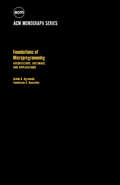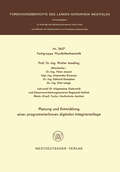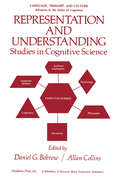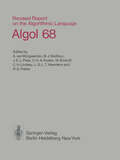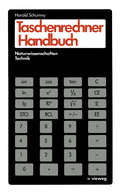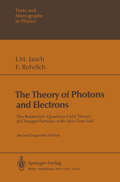- Table View
- List View
Einführung in die Datenverarbeitung: Aufbau und Funktionsweise von Computer-Systemen
by H. SchauerSeit mehr als einem Vierteljahrhundert beeinflußt der Computer unser Leben auf mannigfaltige Weise. Abgesehen von den heute schon selbstverständlichen Anwendungen in Verwaltung, Wirtschaft und Technik hat der Computer auch in Wissenschaft und Forschung seinen festen Platz eingenommen. Viel wichtiger als diese passive Rolle als Hilfsmittel scheint mir jedoch die stimulierende Wirkung, die das Gedankengut der Informatik auf sämtliche anderen Wissensgebiete ausübt. Erst der Computer gab Anstoß für die Behand lung allgemeiner Fragen, wie etwa der Methodik des PlanellS und Handelns oder der Organisation komplexer Systeme. Die dadurch gewonnenen Erkennt nisse können auch in vielen anderen Disziplinen angewandt werden. Möge dieses Buch einen Beitrag dazu leisten, daß bei einem weiten Leserkreis Inter esse für dieses neue Wissensgebiet geweckt wird. Manfred Brockhaus Vorwort Wie der Titel dieses Buches verspricht, macht es den Leser mit dem Aufbau und der Funktionsweise von Computer-Systemen vertraut. Darüber hinaus werden die einschlägigen Fachbegriffe erklärt, was sowohl für das Studium weiterführender Literatur als auch für Fachgespräche mit "Computer-Spezia listen" unumgänglich ist. Der Text wendet sich sowohl an Studierende der Informatik und aller anderen Studienrichtungen, die in irgendeiner Form mit Datenverarbeitung konfron tiert sind, als auch an all jene, die beruflich mit Computern zu tun haben und ihre praktische Erfahrung auf eine Basis fundierter Allgemeinkenntnisse stellen wollen.
Encyclopedia of Computer Science and Technology: Volume 3 - Ballistics Calculations to Box-Jenkins Approach to Time Series Analysis and Forecasting (Computer Science And Technology Encyclopedia Ser.)
by Jack Belzer Albert G. Holzman Allen Kent"This comprehensive reference work provides immediate, fingertip access to state-of-the-art technology in nearly 700 self-contained articles written by over 900 international authorities. Each article in the Encyclopedia features current developments and trends in computers, software, vendors, and applications...extensive bibliographies of leading figures in the field, such as Samuel Alexander, John von Neumann, and Norbert Wiener...and in-depth analysis of future directions."
Encyclopedia of Computer Science and Technology: Volume 5 - Classical Optimization to Computer Output/Input Microform
by Jack Belzer Albert G. Holzman Allen Kent"This comprehensive reference work provides immediate, fingertip access to state-of-the-art technology in nearly 700 self-contained articles written by over 900 international authorities. Each article in the Encyclopedia features current developments and trends in computers, software, vendors, and applications...extensive bibliographies of leading figures in the field, such as Samuel Alexander, John von Neumann, and Norbert Wiener...and in-depth analysis of future directions."
Encyclopedia of Computer Science and Technology: Volume 5 - Classical Optimization to Computer Output/Input Microform
by Jack Belzer Albert G. Holzman Allen Kent"This comprehensive reference work provides immediate, fingertip access to state-of-the-art technology in nearly 700 self-contained articles written by over 900 international authorities. Each article in the Encyclopedia features current developments and trends in computers, software, vendors, and applications...extensive bibliographies of leading figures in the field, such as Samuel Alexander, John von Neumann, and Norbert Wiener...and in-depth analysis of future directions."
Encyclopedia of Computer Science and Technology: Volume 3 - Ballistics Calculations to Box-Jenkins Approach to Time Series Analysis and Forecasting (Computer Science And Technology Encyclopedia Ser.)
by Jack Belzer Albert G. Holzman Allen Kent"This comprehensive reference work provides immediate, fingertip access to state-of-the-art technology in nearly 700 self-contained articles written by over 900 international authorities. Each article in the Encyclopedia features current developments and trends in computers, software, vendors, and applications...extensive bibliographies of leading figures in the field, such as Samuel Alexander, John von Neumann, and Norbert Wiener...and in-depth analysis of future directions."
Entwicklung von Algorithmen zur Aufbereitung komplizierter Netzplanstrukturen für eine maschinelle Netzplandarstellung (Forschungsberichte des Landes Nordrhein-Westfalen #2534)
by Andreas SchmitzFoundations of Microprogramming: Architecture, Software, and Applications
by Ashok K. Agrawala Tomlinson G. RauscherFoundations of Microprogramming: Architecture, Software, and Applications discusses the foundations and trends in microprogramming, focusing on the architectural, software, and application aspects of microprogramming. The book reviews microprocessors, microprogramming concepts, and characteristics, as well as the architectural features in microprogrammed computers. The text explains support software and the different hierarchies or levels of languages. These include assembler languages which are mnemonic or symbolic representation of machine commands; the procedure oriented machine-dependent; and the procedure oriented machine independent. A simulator is used to interpret programs written in machine or micro-language before the instructions in the program can be run. A simulator and translator (which change some steps from one program written in another language to another program) should interface with the design language of the computer for these components to operate even when a new machine is developed. The book cites four existing computers which have "simple" diagonal microinstructions such as the Hewlett-Packard HP21MX and the Microdata 3200. Horizontal types of microinstructions allow parallel execution of many micro-operations, such as the Cal Data family of computers, the Varian 73, and the NANODATA QM-1. Microprogramming is applied in emulation, program enhancement, operating systems, signal processing, and graphics. The text can benefit programmers, computer engineers, computer technicians, and computer instructors dealing with many aspects of computers such as programming, hardware interface, networking, engineering or design.
GI — 6. Jahrestagung: Stuttgart, 29. Sept. – 1. Okt. 1976 (Informatik-Fachberichte #5)
by E. J. NeuholdInformatik: Zweiter Teil: Aufgaben und Lösungen (Heidelberger Taschenbücher #160)
by F. L. Bauer R. Gnatz U. HillPlanung und Entwicklung einer programmierbaren digitalen Integrieranlage (Forschungsberichte des Landes Nordrhein-Westfalen #2607)
by Walter AmelingProgrammiersprachen: 4. Fachtagung der GI Erlangen, 8.–10. März 1976 (Informatik-Fachberichte #1)
by H. J. Schneider M. NaglProzeßautomatisierung I: Aufbau und Programmierung von Prozeßrechensystemen (Hochschultext)
by R. LauberRechnen in der Chemie: Grundoperationen - Stöchiometrie
by Walter WittenbergerEs wird sicher eInIge Zeit dauern, bis in der Praxis die neuen gesetzlichen Einheiten ausschließlich verwendet werden. Um den übergang zu erleichtern, wurden - wo es angebracht schien - die früheren Einheiten in Klammer gesetzt. Selbst verständlich sind auch die erforderlichen Umrechnungstabellen eingefügt. Am Schluß des Buches sind einige wichtige Tabellen sowie die fünfstellige Logarithmentafel aufgenommen, um vor allem dem Anfänger den Gebrauch dieser Rechenhilfen und das Auf suchen und Interpolieren von Tabellenwerten zu erleichtern. Ein Buch wird seinem Benutzer dann zum Erfolg führen, wenn er es oft und gern zur Hand nimmt. Wenn ein Buch, wie das vorliegende, bereits neun Auflagen erreicht hat, kann angenommen werden, daß diese Voraussetzung erfüllt ist. Der Springer-Verlag in Wien hat durch die vorbildliche Aus stattung des Buches dieses Bestreben unterstützt, wofür ihm aufrichtig zu danken ist. OffenbachJMain, im Frühjahr 1976 Walter Wittenberger Inhaltsverzeichnis 1. Allgemeines Rechnen .................................. 1 A. Mathematische Schreibweise und Genauigkeit .......... 1 Dezimalzahlen und vielstellige Zahlen 1. - Genauigkeit im Zahlenrechnen 1. - Mathematische Zeichen 3. Formel- und Einheitenzeichen 3. - Dezimale Vielfache und dezimale Teile von Einheiten 3. - Das griechische Alphabet 4. B. Bruchrechnen ..................................... 4 Teilbarkeit der Zahlen 4. - Umformen von Brüchen 4. - Kürzen und Erweitern von Brüchen 6. - Addieren von Brüchen 7. - Subtrahieren von Brüchen 7. - Multipli zieren von Brüchen 7. - Dividieren von Brüchen 8. C. Proportionen (Verhältnisgleichungen) ................. 9 Schlußrechnung (Dreisatz) 9. - Proportionen 10. - Der abgekürzte Dreisatz 11. - Umgekehrte Verhältnisse 12.
Rechnernetze und Datenfernverarbeitung: Fachtagung der GI und NTG, Aachen, 31.3.–2.4.1976 (Informatik-Fachberichte #3)
by D. Haupt H. PetersenRepresentation and Understanding: Studies in Cognitive Science
by Allan Collins Daniel G. BobrowRepresentation and Understanding
Revised Report on the Algorithmic Language Algol 68
by A. Wijngaarden B. J. Mailloux J. Peck C. Koster C. H. Lindsey M. Sintzoff L. T. Meertens R. G. FiskerSimulationstechnik: Entwurf und Simulation von Systemen auf digitalen Rechenautomaten (Hochschultext)
by K. Bauknecht J. Kohlas C.A. ZehnderSoftware Engineering Education: Needs and Objectives Proceedings of an Interface Workshop
by A. I. Wasserman P. Freeman"Software engineering" is a term which was coined in the late 1960's as the theme for a workshop on the problems involved in producing software that could be developed economicaLly and would run reliably on real machines. Even now, software engineering is more of a wish than a reality, but the last few years have seen an increased awareness of the need to apply an engineering-type discipline to the design and construction of software systems. Many new proposals have been made for the management of software development and maintenance and many methodologies have been suggested for improving the programming process. As these problems and solutions become better understood, there is a growing need to teach these concepts to students and to practicing professionals. As a prelude to the educational process, it is necessary to gain an understanding of the software design and development process in industry and government, to define the appropriate job categories, and to identify the fundamental content areas of soft ware engineering. The need for quality education in software engineering is now recognized by practitioners and educators alike, and various educational endeavors in this area are now being formulated. Yet, discussions we had had over the past year or so led us to believe that there was insufficient contact between practitioners and educators, with the resultant danger that each group would go off in separate ways rather than working together.
The Theory of Photons and Electrons: The Relativistic Quantum Field Theory of Charged Particles with Spin One-half (Theoretical and Mathematical Physics)
by Josef M. Jauch F. RohrlichSince the discovery of the corpuscular nature of radiation by Planck more than fifty years ago the quantum theory of radiation has gone through many stages of development which seemed to alternate between spectacular success and hopeless frustration. The most recent phase started in 1947 with the discovery of the electromagnetic level shifts and the realization that the exist ing theory, when properly interpreted, was perfectly adequate to explain these effects to an apparently unlimited degree of accuracy. This phase has now reached a certain conclusion: for the first time in the checkered history of this field of research it has become possible to give a unified and consistent presen tation of radiation theory in full conformity with the principles of relativity and quantum mechanics. To this task the present book is devoted. The plan for a book of this type was conceived during the year 1951 while the first-named author (J. M. J. ) held a Fulbright research scholarship at Cambridge University. During this year of freedom from teaching and other duties he had the opportunity of conferring with physicists in many different countries on the recent developments in radiation theory. The comments seemed to be almost unanimous that a book on quantum electrodynamics at the present time would be of inestimable value to physicists in many parts of the world. However, it was not until the spring of 1952 that work on the book began in earnest.







